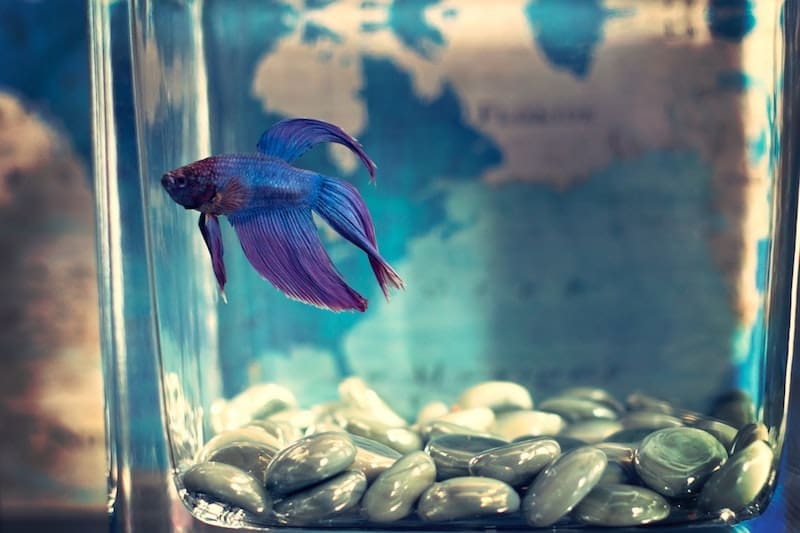
How Long Can Fish Live in Tap Water?
The answer to this question depends on a variety of factors, such as the type of fish, the temperature of the water, and the amount of oxygen present. Generally speaking, most species of freshwater fish won’t live long if the tap water isn’t treated. Untreated tap water can quickly kill fish in just a matter of hours.
Treated tap water, however, is free of chlorine and other chemicals and can provide a suitable environment for certain species of fish, such as molly fish. Mollies thrive in a slightly alkaline environment, so as long as the tap water is properly treated and balanced, they can live without issue.
Some species of fish require a more specific environment than what’s provided by tap water. Cichlids are one such example. These fish require a pH balance between 7-8 and prefer soft, acidic water that is free of chlorine and ammonia. If the tap water isn’t properly treated and oxygenated, they may not survive.
When it comes to goldfish, they are one of the hardiest species of fish and can live in untreated tap water if the temperature is between 18-22 °C (64-72 °F). However, this is only recommended for short periods of time, and the water should be monitored closely for signs of disease.
Ultimately, how long a fish species can live in tap water depends on the species of fish and whether or not the water is treated. If you’re thinking about keeping a fish in tap water, it’s important to do your research first to ensure they have all the necessary requirements to thrive.
Why Can’t Fish Live in Untreated Tap Water?
Fish depend on the specific chemistry and temperature of their home environment in order to survive. When traditional aquarium fish are put into tap water, they experience a drastic change in chemical composition and temperature, which can be toxic or even fatal to them.
Freshwater Fish vs Tropical Fish
The primary difference between freshwater and tropical fish is the level of dissolved minerals that are present in the water. Freshwater fish tend to be more tolerant of variation in water chemistry, while tropical fish prefer a steady environment with specific mineral levels.
Water Quality
Tap water is not filtered or treated when it comes directly from the pipes, so it contains harmful substances like dust, suspended particles, and even parasites. This can cause physical irritation to the fish gills or other organs.
Harmful Chemicals
Additionally, tap water also contains chlorine which is added by local governments as a disinfectant to kill bacteria in the water supply and make it safe for human consumption. Chlorine, however, is toxic to many species of fish and can cause acute respiratory distress or even death.
Ammonia Poisoning
Finally, tap water also contains high levels of ammonia, which is toxic to fish. Ammonia is a natural by-product of the breakdown of organic matter and can quickly build up in an aquarium if it is not properly filtered or treated.
Don’t let tap water kill your fish. Whether you’re raising betta fish, paradise fish, or any other fresh water fish, make sure you’re treating tap water before adding it to your fish tank.
Understanding Ammonia and the Importance of Water Change
Ammonia in high amounts ishighly toxic to your fishand other aquatic creatures. The dissolved gas is produced by fishes and eventually becomes an issue in aquarium tanks. Feeding in larger amounts also contributes to the rise of the ammonia level in the closed environment. As a fish waste byproduct and decomposing organic matter, ammonia must be kept at 0 parts per million or ppm to prevent ammonia poisoning or fish kill. The common causes of ammonia poisoning are the loss of beneficial bacteria that convert ammonia during the nitrogen cycle, changes in bio-load due to overstocking, overfeeding, and the lack of water changes.
What are the Signs and Symptoms of Ammonia Poisoning
If your pet fish is no longer eating its pellets or is hovering at the bottom of the tank, then your fish is experiencing ammonia poisoning. You will also notice redness in the gills which is a sign that you’re dealing with high levels of ammonia. In tanks with high levels of ammonia, the fish may experience internal or external bleeding which may result in death.
How to Keep Ammonia Level at Bay in Tap Water
There are a few ways to maintain 0ppm including reducing feeding, installing a good bio-filtration system, algae scrubber, and weekly water changes. Regardless of the species, you need to invest in good quality filter media for your bio-filter system. The beneficial bacteria that live in the filter media help in keeping the ammonia level at bay by converting it into nitrite.
Nitrite and Nitrate Contamination
The Dangers of Nitrite and Nitrate
Although nitrite and nitrate are less harmful compared to ammonia, it can still harm your pet fish in larger amounts. Nitrobacter is a nitrifying bacteria that converts nitrite into nitrate which plants and algae feed on. The nitrogen cycle involves the breaking down of ammonia and its conversion into nitrite then nitrate. In smaller amounts, your fish will live with little to no health problems. High levels of nitrite and nitrate will have an adverse effect on the health of your fish. Fortunately, you can maintain low levels of nitrite and nitrate with regular water changes.
Heavy Metals Toxicity
Heavy Metals in Tap Water
Another threat to your fishes are the heavy metal contaminants found in tap water. Lead, mercury, cadmium, and arsenic are among the common heavy metals found in private wells and sometimes in your municipal water supply. If you have any of these in your tap water, there’s a high chance you’ll kill your fish within a few hours. Heavy metals in the water are toxic to any living organism even in smaller amounts.
How To Help Your Pet Fish Live in Tap Water
There are a few things you can do to ensure your pet fish are living in the best quality water.
Let the Tap Water Sit
One way to help your pet fish live in tap water is to let it sit overnight before introducing it into the tank. This allows the volatile compounds and chlorine to dissipate from the water, reducing its harmfulness to the fish.
Boil the Water
Another option for improving tap water quality is to boil it before you add it to the tank. Boiling water eliminates chlorine, nitrates, and other toxins that may harm your fish. However, this should only be done occasionally; boiling will also reduce important minerals in the water that are beneficial for your fish’s health.
Use Water Conditioner
Another way to help your pet fish live in tap water is to use a water conditioner. Water conditioners are formulated with specific compounds that will neutralize chlorine, chloramine, and heavy metals (such as copper and zinc) found in tap water. This helps improve the overall quality of the water and makes it safer for your fish.
Install a Reverse Osmosis Water Unit
Another way to help your pet fish live in a fish tank with tap water is to install a reverse osmosis (RO) water unit. These units are designed to filter out impurities from the water, such as chlorine, heavy metals, and nitrates.
Although these units can be expensive, they provide the highest quality of filtration for a fish tank and are a great way to ensure your fish are living in clean, safe water.
Remove Chlorine With Ultraviolet Light
Finally, you can help your pet fish live in tap water by using an ultraviolet light (UV) filter. UV filters use short-wave radiation to break down chlorine molecules, rendering them harmless and improving the quality of the water.
However, UV filters should only be used in fish tanks that have adequate filtration; if not, they can cause an increase in bacteria levels which can be harmful to your fish.
Water Chlorination and Fish Death
Water chlorination is a process where chlorine is added to the water from your water supply. The practice is used to eliminate bad bacteria and microbes in tap water. Chlorinated water is toxic to your fish when exposed within an hour or more.
In fact, chlorinated water is among the leading cause of fish kill among hobbyists around the world. Use a chlorine neutralizer when you perform a water change to remove the chlorine.
Filtered Water vs. Tap Water
For some fish owners, tap water is the only option available. But as we mentioned, tap water usually contains chlorine and other chemicals that are used to treat it to make drinking water for humans.
These chemicals can be toxic to fish and can cause a variety of health issues, including skin lesions, organ damage, impaired growth, and decreased immunity.
However, if you have a home aquarium and good access to tap water, it can be possible to make your own safe fish tank environment with the help of a dechlorinator.
Dechlorinators are products that are designed to neutralize chlorine and chloramine in tap water before you add it to your tank. These products usually come in liquid or tablet form, and they are easy to use. Make sure to read the instructions on the packaging before adding a dechlorinator to your tank.
Another option is filtered water, which is becoming increasingly popular among fish owners. Filtered water is typically free of chlorine, chloramine, and other chemicals that can harm your fish. It also has fewer impurities and contaminants, making it a healthier choice for your fish.
Filtered water can be purchased from most pet stores or online retailers and typically comes in 5-gallon jugs or larger containers.
Can Fish Survive in Distilled Water?
No, distilled water is not suitable for fish to survive. Distilled water does not contain enough essential minerals and nutrients that are necessary for fish to live and thrive. In addition, the lack of ions in distilled water may lead to osmotic shock, which can be fatal to fish.
What is the Best Water for A Fish Tank?
The safest water for fish to thrive in is reverse osmosis (RO) water. RO water has been filtered to the point where it no longer contains most impurities, pollutants, and chemicals.
It’s widely considered to be the best option for any fish tank because it is free of chlorine and other contaminants that can cause illness or death in aquarium inhabitants. In addition, RO water helps maintain a balanced pH level in the tank, which is crucial for fish health.
How Water Filters Help in Keeping the Water Clean
The AquaOx whole house systems are designed to keep impurities from entering your faucets. Not only will they keep your fish safe, but also your family. As a fish hobbyist, you’ll benefit from installing a water filter because of its ability to catch and eliminate pollutants that threaten your fish’s health. Once you’ve conducted a water test and found the culprit, purchase and set up the ideal filter system to eliminate the contaminant. Keep your water quality in top condition by doing regular water changes and with the help of a reliable water filter treatment system.







